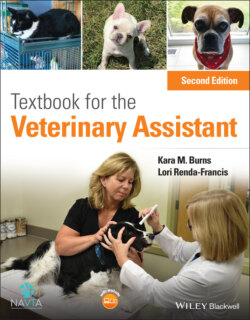Читать книгу Textbook for the Veterinary Assistant - Lori Renda-Francis - Страница 29
Axial skeleton
ОглавлениеThe cranium is the portion of the skull that encases the brain. The mandible and maxilla are two significant facial bones. The mandible forms the lower jaw, and the maxilla forms the upper jaw. The eye sockets in the skull are known as the orbits (Figure 3.7).
Figure 3.7 Cranium.
Source: Courtesy of Jennifer Smith, LVT.
The hyoid bone (also known as the hyoid apparatus) is made up of several parts that may be cartilage or bone. It is a U‐shaped structure that is located above the larynx and below the mandible and is suspended by ligaments.
Ribs are pairs of flat, curved bones that attach dorsally to the thoracic vertebrae. The cartilage at the end where the rib attaches to the sternum is called the costal cartilage. The sternum is also known as the breastbone, and it forms the ventral midline of the rib cage. The ribs that are not attached to cartilage are known as floating ribs. Cats and dogs have 13 pairs of ribs.
The vertebral column is also known as the backbone and is made up of numerous vertebrae. There are five different types of vertebrae, and there are variations among species in the number of each different type. Here, we focus on the number of vertebrae in canine and feline patients.
The main functions of the vertebral column, also known as the spinal column, are to support the head and body and to protect the spinal cord. The vertebral column is made up of individual bones called vertebrae.
The cervical vertebrae are the vertebrae of the neck. There are a total of seven cervical vertebrae in all domestic mammals. The first one is called the atlas and the second one is called the axis. The thoracic vertebrae are the vertebrae of the chest. The ribs are attached to these vertebrae. There are 13 thoracic vertebrae in the cat or dog. The lumbar vertebrae are the vertebrae of the lower back. There are a total of seven in cats and dogs. The sacral vertebrae (also known as the sacrum) consist of three fused vertebrae to which the pelvis is attached. Finally, the coccygeal vertebrae are the vertebrae of the tail, and the number of coccygeal vertebrae can vary between six and 23 depending on the species and whether the tail has been docked.
Vertebral formulas are written in a specific format and vary from species to species (Figure 3.8). For example, the dog or cat vertebral formula would look like this:
C‐7, T‐13, L‐7, S‐3, Cy 0‐23
